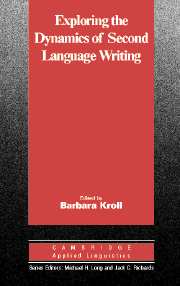Book contents
- Frontmatter
- Contents
- List of contributors
- Acknowledgments
- List of abbreviations used
- Series editors' preface
- Introduction: Teaching the next generation of second language writers
- I EXPLORING THE FIELD OF SECOND LANGUAGE WRITING
- II EXPLORING THE VOICES OF KEY STAKEHOLDERS:TEACHERS AND STUDENTS
- III EXPLORING WRITERS' FINISHED TEXTS
- Chapter 5 Responding to writing
- Chapter 6 Grammar and the ESL writing class
- Chapter 7 Writing teachers as assessors of writing
- IV EXPLORING CONTEXTUALITIES OF TEXTS
- V EXPLORING TECHNOLOGY
- EPILOGUE: EXPLORING OURSELVES
- Index
Chapter 6 - Grammar and the ESL writing class
Published online by Cambridge University Press: 05 October 2012
- Frontmatter
- Contents
- List of contributors
- Acknowledgments
- List of abbreviations used
- Series editors' preface
- Introduction: Teaching the next generation of second language writers
- I EXPLORING THE FIELD OF SECOND LANGUAGE WRITING
- II EXPLORING THE VOICES OF KEY STAKEHOLDERS:TEACHERS AND STUDENTS
- III EXPLORING WRITERS' FINISHED TEXTS
- Chapter 5 Responding to writing
- Chapter 6 Grammar and the ESL writing class
- Chapter 7 Writing teachers as assessors of writing
- IV EXPLORING CONTEXTUALITIES OF TEXTS
- V EXPLORING TECHNOLOGY
- EPILOGUE: EXPLORING OURSELVES
- Index
Summary
Good writing is indeed an elusive concept, one that varies according to the entire rhetorical situation in which it is produced. It is clear, however, that certain properties of good writing can be identified. Most would concur that for writing to be deemed “successful” to its overall purpose, it must conform to the conventions of English syntax and usage, generally referred to as grammar. Grammar is indisputably an essential element of second language writing instruction, but the ways in which it is integrated with other components of writing courses have varied.
Until the introduction in the 1980s of communicative language teaching, grammar was often the main curricular focus in English as a second language (ESL) writing instruction: Courses concentrated on having students manipulate and master grammatical forms with little attention to the content or organization of the texts they were producing. More recently, grammar instruction has been assigned a less prominent role in second language writing classrooms. For example, in classrooms that follow a process model, the writer, the content and purpose, and multiple drafts are central and grammar is often reserved until the final editing phase. In genre-based classrooms, the central focus is on the type of text (e.g., research report, summary, problem-solution text) as well as the content, organization, and audience considerations that it entails. Here grammar instruction derives from an analysis of the dominant grammatical features of a given text type (e.g., past tense in the methods section of a research report).
Information
- Type
- Chapter
- Information
- Exploring the Dynamics of Second Language Writing , pp. 141 - 161Publisher: Cambridge University PressPrint publication year: 2003
Accessibility standard: Unknown
Why this information is here
This section outlines the accessibility features of this content - including support for screen readers, full keyboard navigation and high-contrast display options. This may not be relevant for you.Accessibility Information
- 21
- Cited by
